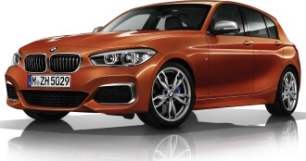So, it’s a little BMW, does that mean the price is little? Nope. It’s like asking if a little Rolex is cheap. it might be cheap for a Rolex, but not for a watch in general, and it's the same for the 1 Series.
The 1 Series range starts at $39,990 for the petrol 118i, while its 118d diesel twin is $44,990. Both come with the standard Sport Line package, which adds 16-inch light alloy wheels and LED headlights, while in the cabin it brings cloth upholstery, sports seats and a leather sports steering wheel, high-gloss black trim and BMW scuff plates. Other standard features include a 6.5-inch display, with sat nav, reversing camera, six-speaker stereo, a digital radio and air-conditioning.
The 125i is only a tempting $3000 above the 120i at $49,990 and comes standard with the M Sport Package
For another $7000 you can get into the 120i grade, which lists for $46,990 and comes standard with the Urban Line package, which fits 17-inch alloy wheels in the double-spoke style, adds front and rear bumpers with matt finish air intakes, plus dual chrome tail pipes, while the cockpit gets leather upholstery, and gloss-black and pearl-effect trim.
Along with the Urban Line gear, the 120i has all of the 118i’s standard features and adds more of its own, including front and rear parking sensors, LED fog lights, dual-zone climate control, the interior lights package, plus smart phone connectivity with voice control.
The 125i is only a tempting $3000 above the 120i at $49,990 and it comes standard with the M Sport Package, which is what our most recent test car was fitted with (see the images of the orange 120i). The M Sport pack adds 18-inch light-alloy wheels and the tough body kit, the M Sport steering wheel and aluminium trim to the interior.
Apart from the M Sport package, also standard is an 8.8-inch screen with a DVD player and, somewhat disappointingly, cloth and Alcantara seats. Sure, they look nice, but how did the 120i get real leather and the 125i didn’t?
Still the 125i comes with more impressive performance hardware than the grades below, such as sports suspension, variable steering, M Sport brakes (inner vented rear discs) and blue calipers.
At the top of the 1 Series range is the M140i and while it’s getting into pricey territory at $59,990 (don’t forget that’s not including the on-road costs), you are getting what I’m predicting will be a sought after car in years to come. And possibly even a collector's item.
The M140i isn’t a fully fledged M car – it’s a diet version from the M Performance section of BMW, which gives cars a bit of a taste of the hardcore world of beasties like the M2 and M3, without costing as much or being quite as brutal to drive.
I’ll talk about the high-performance parts more in the sections on driving and engines, but briefly, you might like to know the M140 gets adaptive suspension and a six-cylinder turbo petrol engine – yes in a tiny hatch. Powerful.
The price is bang-on compared to rivals such as the new Mercedes-Benz A-Class and Audi A3
The M140i also has the standard features of the 125i and adds its own, such as the 18-inch alloy wheels, black chrome tail pipe, adaptive LED headlights, leather upholstery, keyless entry, power front seats and a Harmon/Kardon 12-speaker stereo.
So, is the 1 Series good value? The price is bang-on compared to rivals such as the new Mercedes-Benz A-Class and Audi A3 (click those to see my reviews of them, too), but the 1 Series gets less in standard features compared to the Benz (such as Apple CarPlay) and about the same level of equipment as the A3.
If you’re a fan of black and white, you might be relieved to know these are the only two colours you won’t have to pay for. The rest, including Sunset Orange (see the images), Seaside Blue, Melbourne Red, Glacial Silver and Mineral Grey cost $1190.

